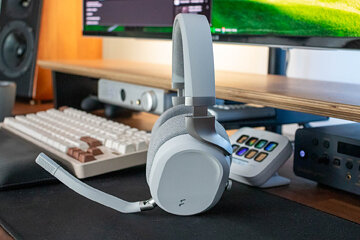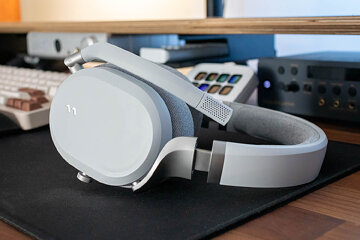 16
16
Fractal Design Scape Review - Debut Done Right
Microphone Performance »Sound Quality
The Fractal Design Scape features custom-tuned dynamic speaker drivers, whose technical specifications aren't revealed by the manufacturer. What we do know is that the specified frequency response spans from 20 Hz to 20 kHz, with the total harmonic distortion being lower than 0.5%, and that the supplied 2.4 GHz Wi-Fi dongle uses the high-quality LC3+ codec to deliver 24-bit/96 kHz audio from the source to the Scape.
For gaming headset frequency response measurements I'm using the miniDSP EARSheadphone test fixture, probably the least expensive such device on the market. It consists of two miniDSP UMIK-1 microphones placed inside a pair of silicone ears and affixed to a steel headphone stand. It's a USB-powered device, perfectly integrated with the fantastic Room EQ Wizard (REW) software, which is used for headphone and microphone calibration, as well as doing the measurements themselves. Every single miniDSP EARS unit comes with its own microphone calibration files, which are loaded into REW before doing the measurements. The miniDSP EARS certainly has its quirks. The artificial ear canals aren't particularly deep, so I wouldn't consider it a viable option for IEM testing. The integrated microphones are exceptionally sensitive to headphone positioning, partially because of the screws affixing the silicone ears to the stand, which aren't perfectly flush with the silicone surface. Some users also claim that the fixture is too narrow for very large Hi-fi headphones, so they have to use rubber bands to tighten the clamping force. The latter isn't something I ever had an issue with, though; all my headsets and headphones fit perfectly.
Because of all that, the miniDSP EARS is prone to user error. Whoever is using it has to know how to interpret the results and, even more importantly, how to spot those that are clearly flawed. After getting rid of the bad data, assuming the initial configuration and calibration were done properly, the resulting frequency response measurements are usable and in line with what one would hear from the headphones (or headset) in question. My testing methodology mostly follows the best practices of using the miniDSP EARS as covered in great detail in this article on Headphonesty. The most significant difference is that I'm using the updated HEQ compensation, where a subjectively neutral headphone would measure approximately flat. To compensate for minor seal variances, I'm measuring each ear until I get 10 usable results and reseat the headphones, or headset, between runs. After I have my results for one ear, I apply a 1/12 octave smoothing and average the measured responses. I then repeat the process for the other ear for an idea of whether any channel imbalance exists. It's important to keep in mind that my results cannot be directly compared to anyone else's, as only an identical methodology conducted on my exact sample of the miniDSP EARS would yield directly comparable results.
For the Fractal Design Scape, I used the supplied 2.4 GHz wireless dongle as the source when doing my frequency response measurements.

The frequency response graph of the Fractal Design Scape clearly shows us a headset that leans toward a clean, analytical sound, with some deliberate tuning choices that push it away from mainstream consumer voicing. Starting in the low end, the Scape displays a nearly flat sub-bass response with no significant elevation. The low end is generally satisfying, but more in the sense that it's tight and clean, rather than rumbly and visceral. Listeners accustomed to cinematic bass drops, EDM punch, or hip-hop thump will likely find this presentation reserved, whereas fans of neutrality and fast bass transients may appreciate the restraint. Let's put it this way—the tuning adheres more to Hi-fi standards than something that you'd expect from a mainstream gaming product.
In the mid-bass and low mids, the graph reveals a subtle downward slope that continues through the 200–600 Hz region. This gradual roll-off avoids midrange congestion but also means that Fractal didn't attempt to make the Scape sound excessively warm. Male vocals and lower-register instruments such as cellos or toms, may lack a tiny bit of body and presence, but it's not something worth losing sleep over. The Scape's tuning here contributes to a sense of cleanliness and separation, and this is something you'll quickly learn to appreciate, both when using it for movies and music, and while gaming. In competitive shooters such as Battlefield 2042, Delta Force and Apex Legends, the Scape provides an outstanding sense of spatial awareness. Your virtual enemies stand no chance sneaking past the Fractal's headset—if they make even a peep, you'll definitely hear it and know exactly where it's coming from. It's worth pointing out that this effect is present both in horizontal and vertical direction; stereo sound coming from the Scape sounds surprisingly three-dimensional.
The midrange is mostly flat and uncolored, giving the Scape a good foundation for vocal clarity and instrumental accuracy. There's a boost around the 2-4 kHz area, which indicates enhanced presence, resulting in vocals—particularly female ones—coming across clear and articulated. The deep and narrow dip centered around 5 kHz is there to avoid sibilance and reduce harshness in consonants and cymbals. It picks up from there, so in the end we get a pleasantly detailed sound, more so than what I'd usually expect from a gaming headset.
Overall, the Scape delivers clarity and detail in spades but does so without excessive warmth or a huge bass impact. As such, it will appeal more to listeners who value precision, articulation, and a studio-like presentation, rather than those seeking a rich, full-bodied listening experience. For analytical listening, acoustic recordings, or competitive gaming, where clarity and separation are key, this tuning has a lot to offer. On the other hand, for listening to bass-heavy genres or poorly recorded material, the Fractal Design Scape may come across as unforgiving and somewhat sterile. In the world of gaming headsets, I'd describe the Scape as grownup-sounding.
In USB mode, the tonality slightly shifts—the Scape sounds slightly sharper and has more bite. The difference isn't huge, but it's definitely there.
The biggest downside of the Fractal Scape's sound performance, at least for me, is its limited maximum volume. While I wouldn't call it too quiet to be usable, it's not particularly loud either. I often found myself using it at 100% volume for both gaming and music, which meant there was no headroom left to turn it up further, whether for a particularly good song or for a more immersive experience. I'm not sure if this is something Fractal can address with a firmware update—it depends on whether it's a limitation of the internal amplifier or a deliberate volume cap. If it's technically possible, the Scape should be made about 30% louder at maximum volume, simply to give users the extra headroom to enjoy more of its clean, detailed sound.
Jul 24th, 2025 22:43 CDT
change timezone
Latest GPU Drivers
New Forum Posts
- RTX 5070 discussion (20)
- Folding Pie and Milestones!! (9640)
- RX7800XT Fan spins at max speed on boot (6)
- AI Job Losses: let's count the losses up, total losses to AI so far 94,000 and counting (62)
- Anime Nation (13064)
- Motherboard Recommendation ? (1)
- Last game you purchased? (872)
- What would you buy? (102)
- TPU's Nostalgic Hardware Club (20572)
- Your PC ATM (35545)
Popular Reviews
- Noctua NF-A12x25 G2 PWM Fan Review
- MSI MPG B850I Edge Ti Wi-Fi Review
- UPERFECT UMax 24 Review
- Cougar OmnyX Review
- TerraMaster F4-424 Max Review - The fastest NAS we've tested so far
- Thermal Grizzly WireView Pro Review
- Sharkoon OfficePal C10 Review - Affordable and Decent
- VAXEE XE V2 Wireless Review
- Upcoming Hardware Launches 2025 (Updated May 2025)
- Razer Blade 16 (2025) Review - Thin, Light, Punchy, and Efficient
TPU on YouTube
Controversial News Posts
- Some Intel Nova Lake CPUs Rumored to Challenge AMD's 3D V-Cache in Desktop Gaming (140)
- AMD Radeon RX 9070 XT Gains 9% Performance at 1440p with Latest Driver, Beats RTX 5070 Ti (131)
- AMD's Upcoming UDNA / RDNA 5 GPU Could Feature 96 CUs and 384-bit Memory Bus (119)
- NVIDIA GeForce RTX 5080 SUPER Could Feature 24 GB Memory, Increased Power Limits (115)
- NVIDIA DLSS Transformer Cuts VRAM Usage by 20% (99)
- AMD Sampling Next-Gen Ryzen Desktop "Medusa Ridge," Sees Incremental IPC Upgrade, New cIOD (97)
- NVIDIA Becomes First Company Ever to Hit $4 Trillion Market-Cap (94)
- Windows 12 Delayed as Microsoft Prepares Windows 11 25H2 Update (92)

